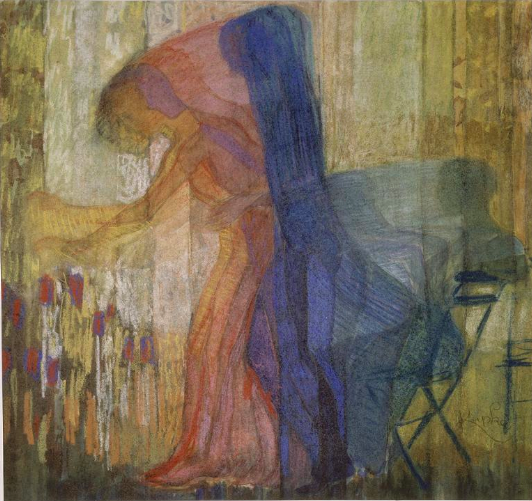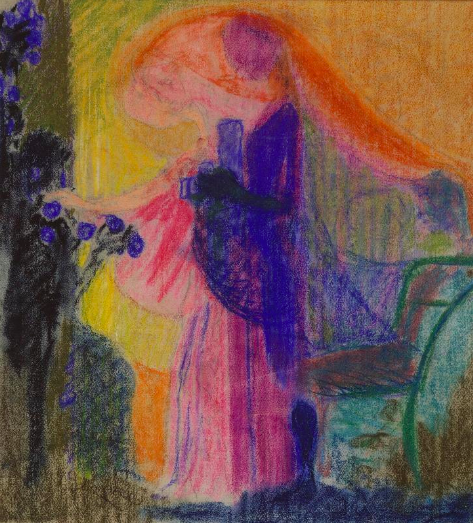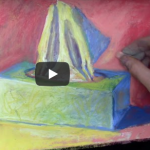Back in April, a pastel was posted by Don Gardi on the Pastel Society of America Facebook page. It was by an artist that was unknown to me – Frantisek Kupka. Once I started to dig a bit, I realized I had seen his work but it was his more abstract paintings that I was familiar with whereas what had been posted was a figure done in pastels. After commenting on the post, I received an email from artist Duane Wakeham who shared an extraordinary pastel by Kupka with me. And from these two beautiful pieces, this blog was born.
Initially I had a hard time finding pastel images online. I borrowed a book, Frantisek Kupka 1871-1957: A Retrospective published by The Solomon R. Guggenheim Foundation, 1975 (which I later discovered online – click here to see it). Inside, I found a number of pastels but they were mostly black and white reproductions. With that information, however, I was then able to track down many of the images online and in colour as posted by the various museums where they reside. (The Musee National d’Art Modern – Centre Pompidou has a large collection of work by Frantisek Kupka primarily due to a gift by his wife Eugenie.)
Short Bio for Frantisek Kupka Prior to 1910
Frantisek Kupka is primarily known as one of the founders of pure abstract art (along with Wassily Kandinsky, Robert and Sonia Delaunay, and Piet Mondrian). Born in Bohemia (now the Czech Republic) in 1871, he studied at the Academy of Fine Arts Prague where he received traditional training, then at the Academy of Fine Arts in Vienna where he was influenced by Symbolism. After moving to Paris by 1896, he studied briefly at the Academie Julian and the Ecole des Beaux-Arts. To earn a living, he first created satirical caricatures for newspapers and magazines and then moved on to designing posters and book illustrations.
He would have been exposed to and influenced by the avant-garde movements of the day – fauvism and cubism – but still his work remained wholly his own. In 1906, he settled in Puteaux, a suburb of Paris (where he lived until he died in 1957). His works started off representational but after reading the Futurist Manifesto published in 1909 in Le Figaro (it’s quite something!), his work began to move more towards abstraction, reflecting the idea of showing movement and also his colour theory. You can read more about Frantisek Kupka’s life here.
The pastels
The pastels I will share with you are from the period 1906-1911, i.e. after he moved to Puteaux up until the time he was being influenced by the Futurist writings and the notion of capturing movement in figures. You can also see how he utilizes colour expressively, beyond any ‘realistic’ associations.


These two pastels look quite different in style – one is more naturalistic with overtones of Kupka’s illustrations for Les Erinnyes (begun in 1906), the other more decorative revealing the Art Nouveau influence with its sinuous lines. The tiny insert reveals a more realistic rendition of what is seen while the larger image studies the effect of water on the figure in a more patterned way.
The beautiful oil painting that emerged from these studies can be seen here. This was the first time Kupka had shown forms immersed and transformed in water. The idea that the natural element of water dissolved the distinct and concrete boundaries of the body appealed to Kupka as seen in this quote from his 2013 manuscript discussing the phenomenon of reflection: “What adorable tricks on the absolute limit of things.” (as quoted in Retrospective, p.107)

This pastel, Girl with a Ball, precedes the fairly naturalistic oil painting of the same subject, namely Kupka’s stepdaughter Andree. Here’s another study:

A series of eight drawings exist that came out of Kupka’s frustrations with being unable to describe movement of the ball and the girl in the pastel (and the painting).
Here’s one drawing where Kukpa describes both the contours and forms of the body as well as the track of the moving ball as Andree plays with it.

In a note on the pencil drawing above, Kupka details his frustrations in the inscription on the side: “ici il n’y a que/ la dissection/ des surfaces/ la conception/ de la/ conpenetration [sic]/ atmospherique/ est a trouver/ tant qu’il y/ aura la difference/ des couleurs/ du fond et/ de la chair/ je retomberai/ dans le [sic] photo/ carte postal”. Loosely translated it means, “Here I am only dissecting surfaces. The atmospheric copenetration is yet to be found. As long as there is a distinction in colour between ground and flesh, I will fall back into the postcard photograph.” (Click here to see the translated quote and to see a much more abstracted pastel study for the painting, Amorpha.)
In the eight drawings of Andree lay the seeds for studies for the painting, Amorpha: Fugue in Two Colours, which, when it was exhibited at the 1912 Salon d’Automne in Paris, was one of the first abstract paintings ever shown publicly.
The Girl with a Ball drawings also led on a parallel track to the colourful and vibrant pastels of the Woman Cutting Flowers series. You can see in these how Kupka worked through the idea of dissecting a plane and of showing motion by using overlapping phases of movement. In these you can also see the influence of high speed photography pioneered in the 1880s.





Apparently there may have been about 15 in this series but the whereabouts of the others are unknown. (Note: the numbers applied to each in the series is from the Retrospective Catalogue rather than the Pompidou’s website where they are all called “Woman Cutting Flowers.” It is unclear in which order they were created.)
It’s fascinating to go through the series, noting the differences and the evolution of the theme. The fourth pastel seems the most abstracted with less focus on overlapping motion; the second loses the seated figure; the fifth one shows the figures most at one with the background.
From the Retrospective Catalogue (p61): “In the last version….although the grid structure is once more visible, the figure is shattered and integrated into the surroundings space. Here Kupka achieves a unified all-over pattern in which focal image, trace or memory imprints and ambient space are fragmented, flattened and enmeshed in a single plane. Kupka wrote in his notebook of approximately the same time (1910-11): ‘When we try to remember a dream…often we only retain a skeleton of the dream images…a vague grid through which fragmented forms emerge and disappear as quickly as they came.’”
Some of these pieces bring to mind Marcel Duchamp’s Nude Descending Staircase #1 and #2 but those weren’t finished until 1911 and 1912. Interestingly, one of Marcel Duchamp’s brothers, Jacques Villon, was Kupka’s neighbour in Puteaux while Marcel himself lived in Neuilly-sur-Seine, another suburb of Paris.
Kupka also began making studies for a piece called Planes By Colours (‘Plans par Couleurs’). Here’s one of those studies:

Amazing colours yes? Click here to see the final oil painting.
The last pastels below lead up to the painting, Planes of Colours, Large Nude. Kupka worked on this series of reclining nudes over a few years starting in about 1904. The first I’ve included is in a private collection and so I was unable to locate a colour version of it. Nevertheless, I’ve included a black and white reproduction of it taken from the Retrospective Catalogue (p. 128) as I feel it really shows his progression from realism to something more expressive. (Sorry about the curve in the page.)



You can see how Kupka used colours (and values) to create the figure rather than volumetric shading. You can see the final oil painting by clicking here.
One more, just one more I promise. Although I was going to stick with figurative pieces, I wanted to include this abstract pastel as it seems to grow naturally out of the Woman Cutting Flowers series. It felt like the completion of Kupka’s process towards abstraction. I think the colour is exquisite! Here it is:

So what do you think? Has this inspired you to work out your ideas in many iterations? I’d love to know if you have any perceptions about this work. Had you seen Frantisek Kupka’s pastels before? Were you even aware of him as an artist? Do let me know in a comment below.
One more blog post coming before I head off to IAPS 2nd of June!!
Until next time,
~ Gail
PS. Because I can’t help myself….

PPS. And here’s the book I referenced:




























14 thoughts on “Frantisek Kupka – Figurative Pastels 1906-1911”
I really enjoyed this write up on an artist I was not aware of……I knew Duchamp and other artists and their Futurist works but not Kupka !
I look forward to reading your posts ! Always really interesting !
Thanks !
Thanks so much Wendy! Yes, I was so surprised that I hadn’t really heard of Kupka before. Not anymore!! Glad I could introduce you to his work 🙂
Brilliant works and so happy you wrote about Kupka. What an artist of broad interests, and certainly a colorist I’m going to look at more.
Glad you enjoyed the pieces Casey. I know, amazing artist! I kept getting sidetracked when I was writing the blog and having to tell myself, No, don’t follow that track – it’s not part of the blog topic. Fabulous colour, fabulous designs. Much there to chew on!
Thanks for researching and putting together such an informative article. I learnt something this morning and I love that. I really enjoyed seeing Kupka’s process through to the finished paintings. His exploration of shape, use of value and the hues are intriguing. Now I want to look up what he wrote about color theory. I found myself thinking of Muybridge and the race horse series as I was reading the article.
You’re most welcome Anne – I’m glad you enjoyed it.I so wanted to put the completed paintings in the blog but since there was already quite a lot to see already and since they weren’t pastels, I chose to put in links instead. Glad to followed them through. If you do look at his colour theory notes, feel free to include any highlights here. And yes to Muybridge. I think I may have to include a link to one of his figure films if I can find them.
This is an amazing coincidence! Having just converted my study to studio, I picked up a pastel picture I started 2 years ago to get it finished. While thinking myself back into it, I decided to rearrange the palette using some ideas of Jan Hart’s. Like me she has a science background and this makes me want to organize things in a systematic way. Referring to pages 14 and 15 of her book I set off on my quest. One of the web sites I visited showed a painting by Kupka called ‘Disks of Newton’, 1912, which is one of a series he did in homage to Newton’s colour circle. Thank you for your article illustrating ways in which he was using the circle in his other work.
Thanks Bernice for commenting and sharing your inspiration for palette organization. I love coincidences!! Glad you enjoyed the article.
A wonderful job Gail! And thanks so much for the mention! It’s nice to hear my post had a positive effect. I’m a big fan of Kupka’s work. The girl with the ball is a favorite. Thanks for the research you have done! I have learned a few new things about him and his work and you posted a few new pastels I have have not seen before.
Many thanks Don! I always enjoy the exploration and research of something that intrigues me. Like I said, it was your posting that lit the spark! And I’m happy that I’ve added to your own knowledge and visual experience 🙂
Thank you! This is an extra – ordinary exploration of this artist, his materials and progression. You have done such a service!
David
David, thank you so much for your enthusiastic response!
It was a lot of work but I do love to put these kind of articles together. Sadly, at the moment, I don’t seem to have the time to do many of these types of deep investigations.
So glad I mentioned my beloved Kupka print to you, lovely to know more about the artist and the studies behind the painting.
I’m glad too!! And I’m happy you remembered to look up this blog post after the workshop